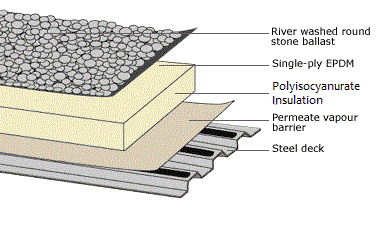Your Guide to Flat Roofing Membranes
When it comes to commercial roofing, there is no shortage of available materials on the market or suppliers who claim they have developed the perfect system for your property. To help you sort through your options and gain a better understanding the pros and cons of each, the team at Jackson Roofing & Son Contracting Inc. has compiled this resource on some of the common flat roofing systems available in Ontario today:

BUR Built-Up Roofing/Hot Tar & Gravel/4Ply Roof
BUR is the oldest and most common roofing type found on buildings 20 years or older. BUR membrane is made up of multiple layers of reinforcing plies of felt paper and asphalt (tar) that form a redundancy of waterproofing layers.
The advantage of a 4Ply compared to a 2Ply or 1Ply roofing system is that if a leak does occur, the water must make its way past 4 layers of felt. Most BUR roofing systems come with a 10-year full systems warranty.
Some of the major manufacturers of BUR products include:

A Completed BUR roof with an asphalt glaze coating being applied to seal the felt paper before the final gravel application.
– Grimsby, ON

Here is the finished product, complete with sheet metal capping and siding (supplied and installed by Jackson Roofing) around the perimeter.
– Grimsby, ON
2 PLY Modified Bitumen Membrane aka Torchdown
Modified Bitumen gets its name from the fact that rubberized modifiers are added to the bitumen (asphalt) to make the bitumen less brittle and more pliable. This is a benefit in our Canadian climate due to the fact that buildings shift and move with our wild temperatures.
The two most common modifiers are APP (attactic polypropylene) and SBS (styrene-butadiene-styrene). The modified bitumen is made in three foot wide rolls of polyester or fiberglass rolls (30' - 40' long).
The Modified roofing system consists of a base sheet layer followed by a granular cap sheet layer heat welded together using roofing torches. The cap sheet can be smooth, but a cap sheet with granules is more common. The granules come in a large variety of colours, from grey to red and black to blue. Most Modified Bitumen roofs come with a 10-year full systems warranty.

2 Ply Modified Bitumen Membrane aka Torchdown
Some of the major manufacturers for Modified Roofing include:

A fully completed grey SOPREMA Torchdown roof. - Paris, ON

A completed brown BAKOR Torchdown roof. - Hamilton, ON

Brown BAKOR Torchdown rolls being set in position over top of base rolls. The rolls of cap are centered over the seams of the base to ensure the seams do not match up; this is called "staggering". The rolls of cap overlap each other by 3" on the edges and 8" on the ends. - Hamilton, ON

Due to its ease of use over Tar & Gravel, Torchdown is often used to preform repairs on older Tar & Gravel roofs. - Brantford, ON

EPDM Membrane
EPDM—Ethylene Propylene Diene Monomer—is a synthetic rubber used in single-ply roofing. Single-ply roofing materials (EPDM, TPO) are becoming more and more popular because of their low costs and extended warranties.
EPDM is often used for new construction due to the fact that it costs nearly half of what you will pay for 4Ply Tar & Gravel and normally comes with twice the warranty. The cost is significantly less because it is easy install, going on in roughly a 1/4 of the time it takes to complete a 4Ply system.
EPDM and other single-ply membranes such as TPO are the roof of choice for most new commercial buildings, commonly adopted by companies such as Canadian Tire, Home Depot, Ferrero Rocher, Procter & Gamble Inc, Hilton, and many more.
Along with its use in large commercial projects, EPDM is readily used in small residential applications. What is attractive about EPDM is that it comes in several sizes ranging from 10' x 100' to 50' x 200' long rolls, which means fewer seams on a large job and possibly none on a small job. Large rolls also mean that larger jobs can be completed quickly. Customers like EPDM because, unlike hot asphalt, there are no obnoxious odours during the installation.
EPDM is a low cost membrane, and when properly applied in appropriate places, its expected life-span (not warranty) has reached 50 years!
Some of the major manufacturers for EPDM Rubber are:

New construction, a loose layer of EPDM in the middle of installation. - Hamilton, ON

The finished project, complete with river stone and patio stone pavers around the HVAC units. - Hamilton, ON

A fully completed EPDM roofing membrane. - Guelph, ON

TPO Membrane
TPO (Thermoplastic Polyolefin single-ply roofing) much like its single-ply brother EPDM, can be fully adhered, mechanically fastened, or ballasted. The main difference between TPO and EPDM is that TPO's seams and accessories are usually heat welded together using electric heat guns.
In some cases TPO seam strengths are reported to be three to four times higher than EPDM roofing systems. It's also a popular choice for "Green" buildings as there are no plasticizers added and TPO does not degrade under UV radiation. It is available in white, grey, and black. Using white roof material helps reduce the "heat island effect" and solar heat gain in the building.
Some of the major TPO membrane manufacturers include:

A mechanically fastened TPO roofing system being layed out.

A TPO heat gun robot in action, these tools run at a selected pace and are the best way to achieve a perfect seam on a long run.

A hand held heat gun is used around roof penetrations and small seams.




















